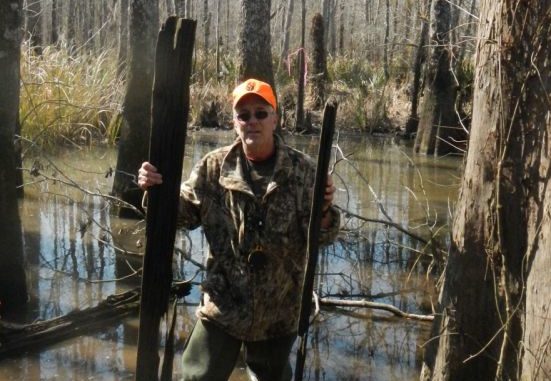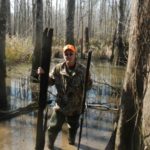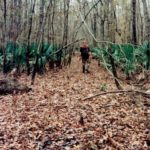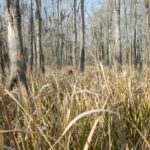
Hurricane Katrina changed everything on Pearl River WMA
The bottoms of my knee boots weren’t gripping the top of the sunken log very well, and I would occasionally slide as I inched my way across the slough. Fortunately, I had stick poles in each hand to help with balance. This might have been a little easier in my younger days, but it was certainly a challenge for this old man to keep his balance with a rifle and hunting pack slung across his back. I knew one thing for certain: I didn’t want to wind up in waist-deep water, so I took my time, and in a few minutes the crossing was over.
I was crossing what us old wildlife guys who have been on Pearl River WMA since the 1970s call the Double Log Slough. This crossing was part of the Old Perch Lake Trail that began on the East Pearl River at the mouth of English Bayou and worked its way south to Perch Lake. It was a major trail for hunters before Hurricane Katrina, providing an easy route into that part of the WMA. Hunters coming up from Wastehouse Bayou would use the trail to go north from Perch Lake.
It was an old logging trail created in the early 1900s to get logs out of the swamp and to the river where they were floated down to a mill. The trail is shown on the 1959 Nicholson Quad map for the area. It used to be on the WMA map that LDWF published but has been removed from the newest edition.
Years ago, I took my son Ruffin hunting in the area during muzzleloader season and made him go with me on the trail to Perch Lake. I wanted him to experience seeing the swamp landscape and see how the ridge system with its oak component was an important part of this ecosystem. I am not sure he appreciated the trek, but it was the last time I have made the entire trip since Katrina hit the swamp in 2005. My crossing of the Double Log Slough this year is probably the last time for me doing that. While the area around this slough is loaded with deer and pigs, it is just too much work to get to it since Katrina has changed the swamp landscape. In fact, as I approached it from Calhoun Slough to the west, I was thinking about how I was going to drag a deer or pig out from this area without killing myself.
Those of you who still hunt PRWMA know what I am talking about. The hurricane wreaked havoc on the oak and gum component of this swamp forest, and hunting on Pearl has not been the same. It is evident from the low turnout for the either-sex days that many hunters have stopped hunting the swamp. In the 70s and 80s, it was common to have 600 to 1,000 hunters on one day, which meant some deer were going to be harvested. Today, it looks like around 100 hunters might show up for the first day, which pretty much insures that the deer kill is going to be low. Managed hunts on WMAs depend on good hunter turnout along with weather that is conducive for hunting, and it appears that hunters are going placers other than Pearl River.
Access into the woods after Katrina was very much restricted, and LDWF has worked hard to open up the trails. The old Perch Lake Trail was still visible after the storm, but the number of downed trees made for difficult walking. You would like walk a few steps, climb over a tree, walk a few steps, go under a tree, and so on. Before Katrina, the closed forest canopy kept the sunlight out and the trail open, but nowadays, sunlight is everywhere on the forest floor, and the vegetation has exploded. In the lower swamp, a panic-type species of grass that grows waist-high has taken over, along with the much taller cut grass. The lower swamp south of English Bayou was pretty good turkey country, but with all the vegetation change, the turkeys have vacated the area; I have not seen turkeys in this part of the swamp in years; it is just too thick for them.
The storm knocked down the large landmark trees I had measured and would use as reference points when maneuvering through the country. Tallow trees have become the dominant mid-story tree, and most of you should know that tallow is considered an invasive species. Because it is so dominant, it has provided shade and reduced the sunlight that hits the ground, opening up areas and making it somewhat easier to move around. Many of the oak trees that were not knocked down were heavily damaged and over time have died. Each year, I notice trees that survived the storm but have now died.
Swamp black gum trees that were common in this part of the swamp have, for some reason, died. Swamp black gum grew on the edge of ridges along the sloughs and cypress ponds. In the fall, they produced a black fruit that was readily eaten by squirrels and deer and no doubt, wood ducks. But for some reason, these trees have died, which has increased the size of the cypress ponds. Cypress and tupelo gum trees fared well during the storm, which shows how important the swamp forest is for protecting the high ground. After the loss of oak trees, the ridges seem to be subsiding, also. I am sure, at some point, a university will begin studying the changes in the Pearl River swamp system and find reasons why these changes have occurred and what it means for the future of this swamp forest.
Oak trees are being regenerated, but it will take another 30 to 50 years for the oak forest to develop, something I will not see. The squirrel population was hammered by Katrina, but it has come back and a hunter can kill a limit of squirrels on a regular basis. Before Katrina, if I did not have my eight squirrels in an hour, I was doing something wrong. The 2016 mast crop was excellent — lots of acorns and hickory nuts — and this will certainly help the squirrel population in 2017. Despite the historic flooding last year, this was a low-water hunting season for the swamp, which meant the deer and pigs were in the lower swamp in the cover and would come out at night on the ridges to feed, then head south before daylight. The harvest data would indicate a poor year, but plenty of deer and lots of hogs are still on this area for brave souls who want to venture into the Katrina woods this year.
There is still squirrel and rabbit hunting to be had on this WMA, so if you are not familiar with it you might want to venture out and hunt small game. It would also be a good time to do some scouting for next year. Hogs are fair game, but there are firearms restrictions. Check out the regulations book. Generally, late winter is the time for high water, so let me suggest knee boots or hip boots. When the water gets high, those crossing logs are not visible at all!


